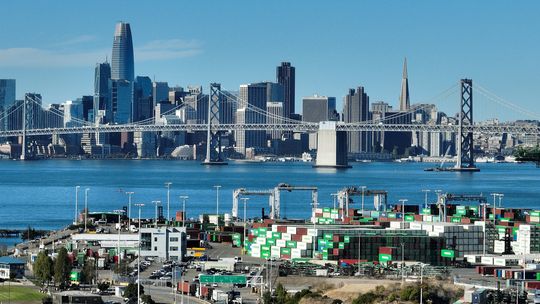GDP forecasts point to steady growth and offer little hint of recession
The U.S. economy expanded at a surprisingly robust 2% pace in the first three months of the year — and it could mimic that performance in the just-ended second quarter.
Gross domestic product is also forecast to grow as much as 2% in the period running from April to June, the most recent Wall Street forecasts show. GDP is the official scorecard for the U.S. economy.
The Atlanta Federal Reserve’s closely followed GDPNow forecast pegs second-quarter growth at 2.2%. S&P Global, perhaps the premier Wall Street forecasting firm, sees the economy expanding at a 1.8% annual clip.
Most other forecasts on Wall Street range from 1% to 2%, but they could fluctuate until the GDP report is released at the end of July. A handful of economic reports yet to be released could alter the final estimates.
What’s behind the surprising resilience of an economy stuck between high inflation and rising interest rates? Strong consumer spending, the backbone of the economy.
Spending surged in the first quarter at the fastest rate in two years, powered by rising wages, surplus savings and a big increase in Social Security benefits.
The wave probably hasn’t crested, either.
“As long as the jobs market remains tight, consumers have income and the economy can keep going and going,” said senior economist Jennifer Lee of BMO Capital Markets. The firm estimates the U.S. will grow at a 1% or so pace in the second quarter.
The labor market has been an oasis of strength for the economy.
Businesses are still hiring at a fast pace and they need to pay more to attract workers. The combination of rising wages and strong job security has given Americans the confidence to spend more.
“We have already created about 80% of the employment in the first five months of 2023 compared to all of 2019,” said chief economist Eugenio Aleman of Raymond James. He was referring to the last full year before the coronavirus pandemic.
The U.S. has created 1.6 million jobs this year through May, keeping the unemployment rate below 4%.
Next week, the government will publish the June employment report. Economists predict the U.S. added another 240,000 new jobs.
The labor market would have to cool off considerably, Aleman said, before the economy could slow enough to tamp down high inflation and get the Federal Reserve to back off from raising interest rates again.
“With the strength of employment it is very difficult to see,” he said. “Employment has to slow down.” Aleman predicts GDP will rise 1.3% in the second quarter.
In the best of both worlds for the Fed, hiring would slow and inflation would, too. Yet as long as most people kept their jobs and unemployment remains low, the economy could either keep growing or experience just a very brief and mild recession.
“The resilience of the labor market is the potential saving grace. It offers the possibility of soft landing,” said senior economist Sam Bullard of Wells Fargo.
He was referring to scenario in which higher interest rates extinguish inflation without triggering a recession. The Fed has only pulled off a so-called soft-landing once since World War Two.
Still, Bullard also believes the odds of a recession are higher. Well Fargo predicts GDP will rise about 1.1% in the second quarter and 1.4% in the third quarter, then gradually weaken and turn negative by next year.
Bill Adams, chief economist of Comerica, even sees a chance that a recession could get underway sooner.
The chief reason: Businesses have scaled back production to get rid of excess inventories, especially given a sharp increase in interest rates over the past year. Less production would also mean less hiring and perhaps more layoffs.
“The Fed’s interest rate hikes are starting to feed through to the real economy,” he said.
Jim Baird, chief investment officer of Plante Moran Financial Advisors, agreed.
“Maybe the recession is delayed, but I still think it is going to be hard to avoid,” he said. “The Fed has a propensity to break the economy by raising interest rates until they do so.”

